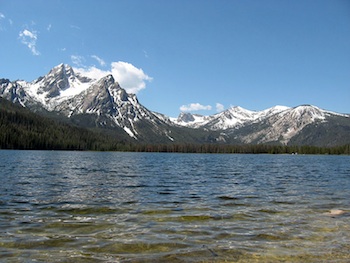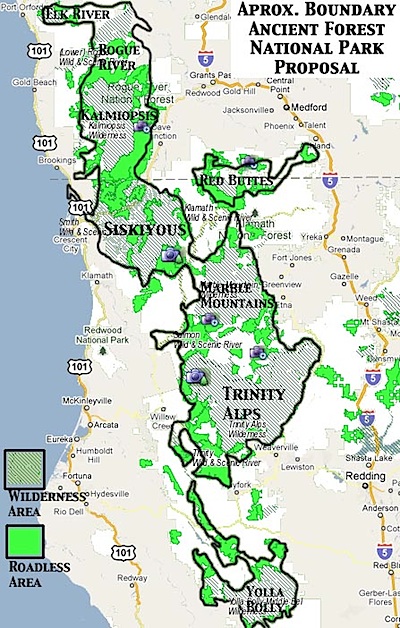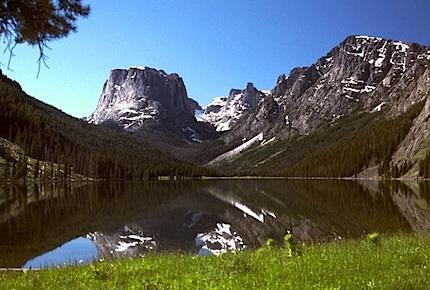Creating national parks doesn't happen every day. Lately, it seems the quickest way to create one is to legislatively redesignate a national monument as a national park (See Pinnacles National Park). But it doesn't hurt to dream, does it?
Here are five picks from the Traveler for new national parks. We offer up these nominees without consideration to fiscal impact because once you start to consider the costs -- mainly economic costs, but also political -- the possible can become impossible. With that understood, we view the following locations as truly spectacular places that should be preserved for future generations.
* Wind River Range, Wyoming
The Wind River Range in west-central Wyoming visibly defines spectacular. With 40 peaks that soar above 13,000 feet, including the state's highest point at 13,809 feet, glaciers, grizzlies, elk, bighorn sheep, lakes and trout streams, this craggy range runs roughly 100 miles north to south and 30 miles east to west.
Currently managed by the U.S. Forest Service, the range contains officially designated wilderness and is one of the country's premier hiking and backpacking areas. The range also harbors the headwaters of the Green River.
You can lose yourself in the Winds for days on end, spot North America's largest herd of bighorn sheep, find challenging climbing routes, or fancy yourself as a latter-day mountain man.
* Sawtooth National Recreation Area, Idaho
This 756,000-acre NRA long has been considered for inclusion in the National Park System. Indeed, back in 1911 a group of women in Idaho called for such a move, according to a history of the NRA's creation.

Stanley Lake in the Sawtooth NRA. Photo by Fredlyfish4 via Wikipedia.
In 1960, then-U.S. Sen. Frank Church introduced legislation to have the area considered for park status, and six years later even introduced a bill calling for Sawtooth National Park, but local opposition derailed it.
This wide expanse of wild lures river runners, climbers, backcountry skiers, anglers, backpackers and more. Cyclists challenge themselves on attacking the highway over Galena Summit, while families carry on long traditions of camping at Redfish Lake.
New England needs another national park, and the one proposed for the North Woods would not just be gorgeous, but would benefit wildlife species such as Canada lynx, Atlantic salmon and the eastern timber wolf threatened with extinction for lack of habitat and protect the "wild forests of New England."
The hardwood forests, lakes, and rivers would help build a strong recreation sector that would pump money into the surrounding towns. The streams and lakes here long have been plied by canoeists.
Talk of creating such a national park extends back over two decades. Proponents, along with pointing to the natural resources that could be protected, believe the cachet of a "Maine North Woods National Park" would bolster the region's economy through businesses that cater to park visitors.
* Ancient Forest National Park, California and Oregon
With climate change under way, protecting migrational routes, and providing migrational routes, for wildlife and even plants is vital to help ensure their survival.

The boundaries of the proposed Ancient Forest National Park run from Oregon south into California.
Park Service Director Jon Jarvis back in August of 2011 called for establishing "a national system of parks and protected sites (rivers, heritage areas, trails, and landmarks) that fully represents our natural resources and the nation's cultural experience." He also cited the need for creation of "continuous corridors" to support ecosystems.
The proposed 3.8-million-acre Ancient Forest National Park spanning parts of southern Oregon and northern California would meet those goals.
Within its proposed borders there already exist officially designated wilderness and roadless areas, places perfect for both recreation and wildlife.
The proposal is to set aside a solid block of land 3.8 million acres from the Rogue River in Oregon to the Eel River in California. It will forever allow the free migration of species from the coast and Redwood National Park to semi arid inland canyons. The park would include already established wilderness areas and already designated critical wildlife areas along with about 1 million acres of unprotected inventoried roadless areas.
* San Rafael Swell, Utah
Talk of turning the Swell into a national park has simmered for decades, going back to the 1930s when local officials proposed a "Wayne Wonderland National Monument." The proposal went nowhere, for the Swell, but is pointed to as an impetus for Capitol Reef National Park.
Nevertheless, the wondrous landscape of colorful reefs of rock, deep canyons, and sandstone walls bearing ancient pictographs remain. So, too, do the tales of outlaws such as Butch and Sundance losing possees by galloping into the maze of canyons. Within the Swell you can find ancient granaries, stone arches, bald eagles, bighorn sheep, feral horses and mules, homesteader cabins, and old mining operations. There are opportunities for canyoneering, river running, backpacking and day hiking and more.
Today there are fewer and fewer pristine and preserved areas left in the country, a fact that has the clock ticking on the few remaining places that deserve national park status. While much opposition no doubt exists to each of the above proposals, they could be crafted in such a way to mollify many of the critics.
By creating a "national park and preserve," the enacting legislation could be written in a way to allow some traditional ways of life, whether they involve grazing livestock, hunting, or logging in a sustainable fashion. Communities could remain in place, with the "park-and-preserve" boundaries excluding them.
What other places do you think should be added to the park system?




Comments
Kurt, your closer to the issue than I am.I'll stop beating around the bush here and come right out and say it's all about money.
I've said yes we need rules and want these lands perserved but the Natl Park Service should keep what they have and quite crying they need more money before one more Natl Park is added.
I've been to all 58 of the so called big Natl Parks,some are run the way they should be run and other are complete zoo's and I don't need to tell you that.
Yellowstone,Great Smoky Mountain,Yosemite just to name a few are parking lots not Natl Parks.Put a few more roads and parking area's in these parks so the people could enjoy these places.Some people go to these places once in a life time what do you think their take is after a visit a coffee cup or a t shirt.The last time I was at Yellowstone I said to myself I just can't stand this anylonger and drove out of the park and that was off season.
The average family isn't going to go to a place like Big Basin where they could experience what a real national park experience can be.
I love the Natl Parks but let's take care of what we have and quite the greed factor in the process.
Quiet Please: Yellowstone and Yosemite are not "parking lots". All you have to do is walk half a mile from the parking lot and you will find solitude. Ninety percent of the tourists in Yosemite, for example, crowd into Yosemite Valley, which isn't even 1% of the area of the park.
I have traveled to many famous cities and parks around the world and I have always been amazed by how 95+% of tourists hang out together in the usual places, missing a lot of wonderful uncrowded attractions that aren't as famous. For example, everyone wants to see Old Faithful, but there are other geysers in Yellowstone that are more spectacular, and completely uncrowded.
Hi Quiet please,
I am glad you love national parks. However, you are missing the big picture.
I have visited most of the full National Parks and more than 240 National Park System areas in total. I have always been able to find solitude and beauty, even in the so-called “zoo” parks at peak season. Yosemite is 89 percent designated wilderness. Why do you spend your time in Yosemite Valley Almost 92 percent of Yellowstone is recommended as wilderness. You couldn’t escape that 8 percent of the park? More than 74 percent of Great Smoky Mountains is recommended as wilderness. That is a lot of backcountry in which to spread out. I have been in “crowded” Acadia National Park on July 4th weekend, and hiked a beautiful trail on the west side of the park with no one else around. If you cannot get away from the crowds in our parks, I think you are hanging out in the wrong places.
Another wrongheaded idea is that we should not add any national parks because we do not have enough money to take care of the ones we have. That old chestnut was debunked long ago. For example:
“Each Park proposed will have powerful and insidious opposition. The insidious opposition to National Parks will say, ‘There is a feeling in Congress that we should not have any more National Parks at this time’; or, ‘We should wait until present ones are improved.’” Sound familiar? This was written by Enos Mills, the father of Rocky Mountain National Park, in his 1917 book, Our National Parks. It was a bogus excuse then, and it is bogus now.
"We have no money; we can do no harm." According to David Brower, National Park Service Director Newton Drury said this to a group of Sierra Club directors at a meeting in the late 1940s. It was in response to the perennial concern that the National Park Service budget was not big enough to ensure the protection of our parks. Drury understood that preserving wild nature does not require a big budget. Most expenses go for infrastructure and visitor services. Isle Royale, Voyageurs, North Cascades, Black Canyon of the Gunnison, Guadalupe Mountains, and Gates of the Arctic National Parks do not have big budgets. They look pretty good to me.
In reality, the National Park Service is by far the best-funded federal land agency, and no doubt better funded than any state land agency. In Fiscal Year 2013, the National Park System budget for land protection and acquisition, education, and recreation programs is $28.60 per acre of parkland, versus only $6.66 per acre for the National Wildlife Refuge System, $2.34 for wilderness and special areas in the National Forest System, and $2.30 for the BLM’s National Landscape Conservation System. Instead of protection, the budgets of the Forest Service and BLM are overwhelmingly devoted to resource extraction and development. In fact, wasteful and ineffective wildland fire “prevention” and “control” programs total 60 percent of the total Forest Service budget. The USFWS budget goes mostly to wildlife research, conservation, promotion, and enforcement programs that, while important, are largely unrelated to managing the National Wildlife Refuge System.
The most urgent thing facing our natural landscapes and historic sites today is that they are being destroyed by resource extraction and industrial development. Most of these areas are on public lands administered by the Forest Service and BLM. We need to focus on saving these areas from increasing exploitation before it is too late. The last thing we should be doing is waiting until the bean counters allocate “enough” money before we protect our disappearing natural and historic heritage.
The world-renowned conservation biologist, Edward O. Wilson, has his priorities straight.
“We should think about the use of national parks in mitigating the effects of climate change, promoting science and science education, saving endangered species, and increasing the quality of life in America by growing the parks in number, in total area, and accessibility to the American people…. We should be talking about expanding the National Park System, not scrambling for crumbs to keep it going. It should be part of the national vision of what will make America great.”
— Dr. Edward O. Wilson, National Parks magazine, Summer 2008
hikertom,enjoy those hikes,Peace
Kurt - citing a number of visitors provides no evidence for or against "deterence." There are 40+ million a year that get speading tickets. Would you argue that speed limits and patrol cars don't deter speeding? The fact that many do it doesn't mean many - even many more - aren't deterred.
There are approx. 43 million households with dogs - presumably, some of them might want to vacation in a park. Unfortunately the NP policy deters that.
Again, you can argue that that deterence is warranted but you can't argue it doesn't exist. And for me, there are far more things objectionable that are allowed than the occasional dog owner that doesn't control/clean-up after his dog.
I guess it comes down to your personal preference, ec. I don't see any NPS regs/rules that deter me from visiting the parks. I have dogs, but not being able to bring them to a park isn't an issue (and, actually, most parks allow you to bring your dogs, even Yellowstone. You just have to keep them leashed and within 100 feet of a road.)
As for cleaning up after dogs, if those 43 million households with dogs starting coming to the parks with their dogs, I'd venture there'd be a bigger mess than you envision...;-)
National Parks are open to everyone. But we're all not allowed to do whatever we want in National Parks--and for good reason. There are rules and deterents to using all sorts of things in our lives. Why single out National Parks' rules as being "petty"? We're not allowed to ride our bike or bring our dog into churches, schools, museums, football stadiums, the U.S. Capitol and more. We're not allowed to walk or pedal our bike on most interstate highways. The rules either protect safety, preserve civility or leave the shared thing in the same general working order for the next person to use and enjoy. It's part of life in a world of more than a scattering of people.
And of course, no one suggested that would be the case. By the way, what do you do with your dogs when you go to a park...put them in a kennel? I find that far more dispicable than a bark or random poop.